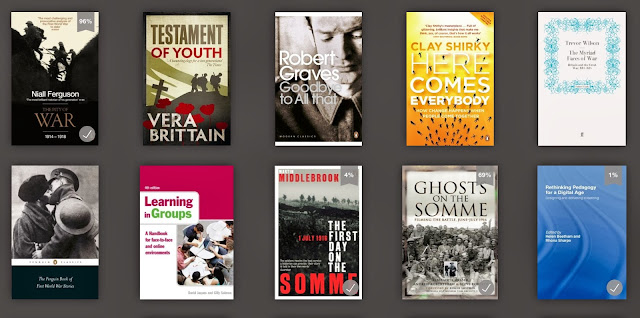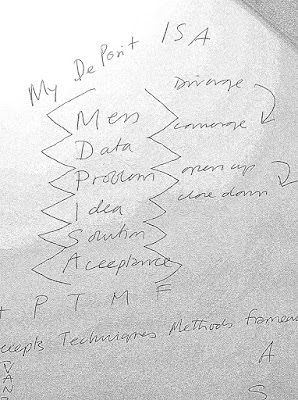This morning I got a lengthy email from someone whose grandfather is featured in a 1918 photograph of RAF cadets I put up on Flickr, I also got a lengthy email from someone sharing a review on a book on the First World War on Amazon. Today, Dan Snow helped launch an initiative through the Imperial War Museum that aims to repeat what the IWM started to do in 1919 - campaign for people to share photographs, artefacts and stories of people who served, suffered, thrived or survived the First World War - this is at the 'Who do you think you are' exhibition at Olympia - I will try to get over on Saturday. And finally, a fascinating conversation with my brother in law on why a gallery curator is inviting people to feedback and respond to works of art through social media - and the curator's philosophy of 'openness' and a desire to move away from the grand voice of the patron in favour of mutliple voices and interpretations. He particularly likes to describe the value of 'dirt' to challenge perceptions and permit the points of view of anyone, and called this dirt 'soil' that would nurture fresh and vibrant ideas - he's Italian, speaks with an accent and chooses his words carefully (he is a tutor in fine art and art history). We got into discussions on learning and why as a student he'd have to queue up early in Bologna in order to hear Umberto Eco. This enthusiastic, reflective discussion continued as he prepares supper and I help - eager to pick up some cullinary tips too.
Personal Blogs
Fig.1. Applying learning on the First World War with e-learning - some Kindle reading.
I believe very much in the process of pulling apart, opening out, expanding, then editing, revising and condensing. There is an applied 'creation process' here - the three diamonds or Buffalo system that I sense H818 is taking us through.
Fig.2. The 'Buffalo' system of opening up, the compressing thinking
These days it is easy to grab and mash any content on a digital screen, but where I have a book I will, in some circumstances take pictures rather than write notes, then quickly bracket and annotate this text before filing it in an appropriate album online - for later consumption.
Regarding CC I'm afraid as the music and movie industries have already shown people will do as they please even where the copyright is bluntly stated. Academia will require and expect that everything is done by the book - the rest of the world won't give a monkey's ... 'we'll' do as we please until there's a legal shoot up or the 'industry' realises that it has moved on.
Regarding eBooks, Amazon are looking at and expect to be very much at the forefront of the evolutionary of the book. Google are competing in the same space.
'Have we reached the Napster moment in publishing?' a senior engineer at Amazon asked.
My head, content wise, is in another place, studying First World War military history. As never before on the MAODE or subsequent OU e-learning modules, I know have content to put into these processes. For example, 'the causes of the First World War' might require reading of a dozen books and papers/pamphlets starting with H G Wells in 1914 and ending with books appearing on tables in Waterstones this week. Courtesy of the Internet just about anything I care to read, at a price, I can have within seconds on a smart device ... or overnight courtesy of Amazon.
Whatever my practice, this content is mashed-up in my head.
If I mash it up through screen grabs, notes, sharing in social media and blogging then this is another expressing of what is going on in my head - though controlled by the parameters of the tools and platforms I use - currently a wordpress blog, SimpleMinds for mindmaps, and 'Studio' for layering text and images over screengrabs i.e annotations. As well as what ever Kindle gives me in the way of notes and highlights.
This kind of 'extra corporeal' engagement or visualization of what is going on in my head with the content gives it an life of its own and an extra dimension while also re-enforcing my own thoughts and knowledge. I'm sure that I am rattling along this learning curve at a far, far greater pace then I could have a decade or two decades ago. Patterns are more apparent. And I am spotting too many misappropriated images too. The idea that you can grab a frame and relabel it is 100 years old!
Fig.3. How I filmed the Front. Geoffrey Malins
For example, the footage from the 'Battle of the Somme' is often 'grabbed' with subsequent combatants and authors claiming these to be original photographs of their own - they must have had access to the negative. This footage, as I am very familiar with it, is repeatedly put into films and documentaries completely out of sequence.
As reference above is correct - I find 'grabs' from the film footage and photographs taken by Ernest Brooks who accompanies the 'cameramen' around the Somme in June/July 1916 constantly claimed as another person's own photograph or belonging to their collection.
A false or alternative impression is therefore built up.
Then, across YouTube, sections of TV dramas and films are snatched and cut into a person's own re-hashing of a different story. Harry Patch died age 111 or something - the last veteran. A tribute to him uses footage from the TV drama staring Daniel Radcliffe called 'My Boy, George".
Are we therefore seeing with text, stills and moving images what has been happening to music for the last decade or more - deliberate, and often illegal sampling and mashing, rehashing, exploiting of someone else's work? If so what impact will this have on content in the future? Does too much of it start to look familiar, rather than original? Or does originality come out of this process too?
The conclusion might be that people simple sidestep the stilted, stuck, formal process of academia - where the sharing process is so desperately slow. The paper I read on use of audio and tracking in a museum I thought was reasonably current as it was published in 2008 but the technology used comes from a different era - 2003. Research done in 2006, initially submitted as a paper in 2007, published the following year.
An R&R department functioning like this would be left behind.
Knowledge must leak, must be shared sooner, and where those share a work in progress it should be commended.
My thirteen years and more studying with the OU has seen how I learn shift. The current twist is looping back to the less distracted days of being 'off line'. At the same time I have done a couple of things that are very old school:
1) A 'Room of my own' without internet access (my choice) .. down the road with an opt in/ opt out. Also an 'office' (I recently bought the domain name Mindbursts.com.
2) Pen and paper ... and by that I mean a fountain pen with ink cartridges and a pad of lined paper - not quite an exercise book, but close.
Why?
1) I am easily distracted. Studying with the Internet 24/7 it is too tempting to be checking email, responding to forum messages or just browsing, I miss linking to books and journals I read about, but these can wait. Maybe the impluse to purchase or read another book weill reduce by the time I get to consider it in the wee hours back at home. My 'room' is ten miles down the road.
2) Partially this is physiological - I am seeing a physio trying to untangle or unknot some hideous pain in my left elbow which I ascribe to typing up blog entries with my left hand while reclined on the sofa or in bed. Partially it is knowing that there is never a short cut to learning and knowing a subject. I truly believe that mixed methods work - that it helps to take the written word and write it out, and type it out, and talk about it and visualise it. Neurologists will confirm that memory formation requires the binding of activity across the brain, rather than from just one part of it.
Meanwhile, I look forward to another e-learning module, H818, with trepidation:
1) I need to demonstrate to myself that I can keep up and even improve on the standard I'm now able to attain. (Time and effort and the only two words to think about).
2) I will be running in tandem with anothe module, taught old-school, at a different university, simultaneously. Already I dread the commute to a monthly day-long tutorial that I can only do by train if I am on a train at 5.20am. It'll make for a very interesting comparison. If the OU offered the module I want to study I would have done it - they don't. This surprises me given the Open Learn work they are doing on the First World War with the Imperial War Museum.
Best wishes to all ... so much for thinking I'd finished with this. Next up I'm applying to the OU to do a PhD so I might be around for a while longer yet.
NOTES
I started an early e-learning module H808 in 2001 ... skipped off the final paper and came back to it all decade later. I have both books and papers from that period which make for amusing reading.
I call it 'War One' having heard American's use this expression; I guess they're up to about War 20 by now? And we can't be far behind. Then again, which war was our first? 1066!
Is the period 2014-2018 a great opportunity to educate?
An excuse to consider what drives nations to War?
H G Wells reflected on this in August 1914 and again in 1936. He was wrong to think it was the 'war to end war' but right to look at economic imbalances and protectionism as a root cause. Who would blame the nations of Africa attacking Western Europe for a piece of the pie?
How is and will the world pie be shared out when so few continue to gather so much to themselves and keep it?
The Open University is running as series of lectures at the Imperial War Museum on 8th July I believe, though for my money, an MA in History with the University of Birmingham has more appeal as its emphasis is on 'War One'.
Afternoon Lecture Series, 2.00pm-4.15pm
2.00pm, The Origins of the First World War
Annika Mombauer, Senior Lecturer in The Open University’s History Department
Was the war an accident, or was it design? This talk will offer an interpretation of the war guilt question based on primary sources and speculate about the possibilities of some different outcomes.
When I last looked 'Modern History' at Oxford only got as far as the 18th century
I think the world wars were considered too recent and were give to PPE (Politics, Philosophy & Economics).
This blog might contain posts that are only visible to logged-in users, or where only logged-in users can comment. If you have an account on the system, please log in for full access.



